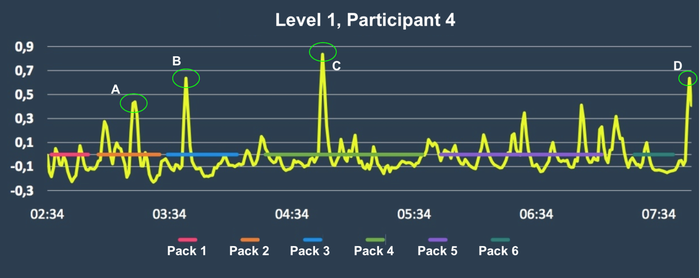Emotional Engagement in Video Games: Measuring Emotions
Understanding and measuring players’ emotional responses is crucial for optimizing gameplay mechanics, narrative elements, and overall game design.

As the video game industry continues to grow, developers are increasingly focusing on creating immersive, emotionally engaging experiences. To that end, understanding and measuring players’ emotional responses is crucial for optimizing gameplay mechanics, narrative elements, and overall game design.
Hello everyone, my name is Maria Amirkhanyan, and I’m a UX researcher at MY.GAMES. In this article, I’ll explain the methods we can use to measure player emotions during gameplay, and how the insights gained from these exercises enable us to improve the overall player experience. We’ll first talk about the many different tools we have at our disposal to assess the emotional state of our players. I’ll then present two real-life case studies from our work that show how we can use some of these tools in practice, and we’ll also discuss the pros and cons of conducting playtests with psychophysiological instruments.
Popular methods of measuring player emotions
Let’s begin our discussion by describing some of the common ways we can measure the emotional engagement of our players.
Facial Expression Analysis: By observing and interpreting facial cues captured via cameras or depth sensors, developers can identify player emotions in real-time to refine gameplay or story elements.
Self-reporting: Players provide feedback on their emotional states during or after gameplay. While this method is subject to bias, it still provides valuable data that can be combined with other methods for a comprehensive understanding of player emotions.
Electroencephalography (EEG): By detecting electrical signals produced by the brain, EEG headsets allow developers to monitor player neural activity and emotional states.
Sentiment Analysis of In-Game Chat: With this method, natural language processing techniques analyze player messages, giving insights into their emotions and the overall emotional atmosphere of the game.
Machine Learning Algorithms: These algorithms process and analyze data from various methods to recognize patterns and predict emotional responses based on players’ in-game behavior and reactions.
Emotion Recognition from Speech: Analyzing the tone, pitch, and intensity of player voices helps developers identify emotional states during gameplay, especially in games that rely on voice communication.
As you can see, we actually have a wide range of tools available to help us here, but in this article, we’ll focus on two in particular:
Physiological Measures: Wearable sensors, such as chest straps or wristbands, monitor biological indicators like heart rate and skin conductance to gain information about player emotional states and help identify emotional peaks and valleys.
Eye Tracking: Monitoring and analyzing eye movement and position helps developers understand player attention and emotional engagement.
Let’s move on and look at some example case studies from our own experience to understand what taking and analyzing these measurements looks like in practice. In the following examples, we’ll focus on two of the aforementioned techniques: taking physiological measures with the aid of a wearable sensor, in our case a GSR (Galvanic Skin Response) sensor, and eye tracking.
Case Study 1: Measuring MMORPG player reactions via GSR
In order to create a more engaging gameplay experience, the development team of one of our MMORPGs decided to test the balance of the mob encounters in a multi-level dungeon. The goal was to ensure that players would feel a sense of tension after each pack of monsters and that the boss fight at the end or middle of each level would serve as a climax of arousal level.

To gather data on player reactions, we conducted playtests in a lab setting using a GSR sensor. The GSR sensor allowed us to track electrodermal activity, that is, the electrical conductance of the skin. This is affected by various factors such as emotional states, physical activity, and environmental factors — in our case, the primary influence on this would primarily be the gameplay itself.
Our results indicated that the first four packs of monsters were appropriately tense for players, with the mini-boss of each pack increasing the level of arousal (see points A, B and C above).
However, during the fifth and sixth packs, players did not experience the same level of tension, and thus, the level of arousal fluctuated. Indeed, the mini-boss of the fifth pack failed to serve as a climax point, and the sixth pack, which was expected to provide the highest climax point, since it was the final pack of the first level of the dungeon, also did not deliver as expected.
Upon analyzing this data, the development team was able to identify areas for improvement and made the appropriate adjustments to the dungeon in order to create a more consistent and engaging experience for players.
It is crucial to remember that a player’s emotional arousal changes in response to our environment, which can increase eccrine sweat gland activity. Both positive and negative stimuli can increase arousal and skin conductance, but the GSR signal only indicates intensity, not the type of emotion experienced. For understanding impressions and positive or negative To determine whether the emotions triggered by the mobs were positive or negative, we used questionnaires and conducted in-depth interviews after the gameplay.
Case study 2: eye-tracking and a racing game
Since interrupting players during actual racing gameplay could reduce their engagement and hinder our ability to determine if our in-game interface was effective (we wanted to see if they noticed all the buttons and text), we didn’t ask questions during the gameplay. Instead, we used eye-tracking to analyze players’ behavior.
Analysis of the eye-tracking data revealed that players focused on the middle of the screen, where they watched the road, enemies, and obstacles, as well as the mini-map in the lower-left corner and the car’s speed in the lower-right corner.
However, players paid little attention to the challenges displayed at the top and middle of the screen, as indicated by the eye-tracking heat map. As a result, we observed that the primary reason players did not complete challenges was due to their limited visibility. However, we were able to determine the rest of the user interface functioned effectively.

Now that we’ve seen some real-life examples of emotional engagement measurement, let’s move on to discuss the pros and cons of conducting playtests with psychophysiological instruments (GSR, EEG, eye tracking, and so on).
Pros of playtests with psychophysiological instruments
Objective data collection: Psychophysiological instruments, such as GSR, EEG, and eye tracking, provide quantitative data that is less likely to have a subjective bias (compared to self-reporting or other observations). This can help accurately assess a player’s cognitive, emotional, and physiological states during gameplay.
Real-time feedback: These tools can capture real-time data, allowing researchers to monitor and analyze players’ responses as they occur during the playtest. This can be useful for identifying points of interest or difficulty in a game, or for determining how effective certain design elements are at evoking desired emotions or reactions.
Unconscious responses: Psychophysiological measures can detect unconscious or automatic responses (such as attention, arousal, or cognitive load) that may not be apparent through self-reporting or observation methods. This provides a deeper understanding of players’ experiences during playtests.
Subtle response detection: Psychophysiological instruments can detect subtle changes in player responses that may not be noticeable through self-reporting or observation. This can help identify nuanced differences between game elements or design choices that can be used to optimize gameplay experiences.
Standardized measures: Psychophysiological instruments often use standardized measures and protocols, which can enable researchers to compare results across different studies or game contexts. This can contribute to a more robust body of research in game design and player experience.
Increased credibility: The use of objective and scientifically grounded methods, such as psychophysiological instruments, can enhance the credibility and rigor of playtesting research. This can help to establish game studies as a respected field and contribute to a broader understanding of player experiences.
Emotional engagement with game narratives: Emotional measurement can reveal how players respond emotionally to game narratives involving characters and mobs, such as plot twists, character motivations, and relationships. This can help developers create more compelling stories that resonate with players.
Cons of playtests with psychophysiological instruments
Cost and accessibility: Psychophysiological instruments, particularly EEG and other neuroimaging tools, can be expensive to acquire and maintain. This may limit the feasibility of using these methods for small-scale or indie game developers.
Complexity of data analysis: The data collected from these instruments can be complex and require advanced statistical analysis or specialized expertise to interpret. This may be a barrier for researchers who do not have experience with these techniques.
Intrusiveness: Some psychophysiological instruments, such as EEG or skin conductance sensors, may require attaching electrodes or sensors to the participant, which can be intrusive or uncomfortable. This may affect the player’s experience during the playtest and potentially influence their behavior.
Potential confounds: Various factors, such as individual differences in physiological responses, anxiety, or fatigue, can influence the data collected through psychophysiological instruments. Researchers need to carefully control and account for these factors to ensure the validity and reliability of their findings.
Technical issues: The use of psychophysiological instruments can be susceptible to technical issues, such as signal noise, artifacts, or equipment malfunction. These issues can impact the quality of the data collected and require careful consideration during data collection and analysis.
Time-consuming: Setting up, calibrating, and analyzing data from psychophysiological instruments can be a time-consuming process. This may slow down the overall pace of playtesting and game development, particularly for smaller teams with limited resources.
Interpretation challenges: The interpretation of psychophysiological data may not always be straightforward, as the relationship between physiological measures and cognitive or emotional processes can be complex and multi-faceted. Researchers must be cautious not to over-interpret or oversimplify their findings based on the data collected.
Artificial environment: Playtests often take place in controlled environments that may not accurately represent the context in which players typically experience games. This can result in emotional responses that are different from those experienced in more natural settings, potentially limiting the ecological validity of the findings.
Limited participant diversity: Conducting playtests in a specific location or lab setting can restrict the participant pool to a particular geographic region, leading to a lack of diversity among participants. This can make it challenging to generalize the findings to a broader audience, as cultural, demographic, or individual differences may influence emotional responses to games.
***
Emotional measurement in playtests can help assess player reactions to so many different aspects of our games: like fear and tension in horror games, the frustration felt from challenging levels, the satisfaction and reward after overcoming tricky obstacles, the impact of antagonist actions and emotional conflict, and the humor and entertainment value of characters. We can then use this information to optimize game design, game balance, and overall player experience. These insights also help developers incorporate more effective narrative elements which evoke specific emotions and create memorable experiences for players.
Bonus:
In this video, Mike Ambinder, PhD, a principal experimental psychologist at Valve, discusses how psychophysiological methods can be used to improve the player experience during playtests and adapt gameplay accordingly. By leveraging these methods, game developers can create a smoother and more exciting gameplay experience for players.
Read more about:
BlogsAbout the Author
You May Also Like









